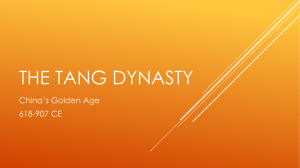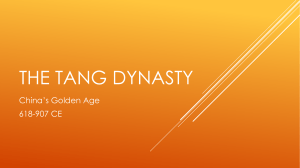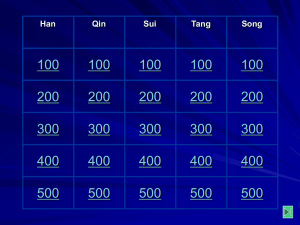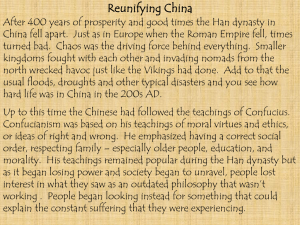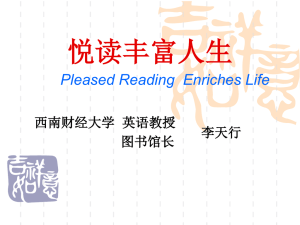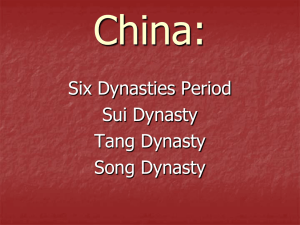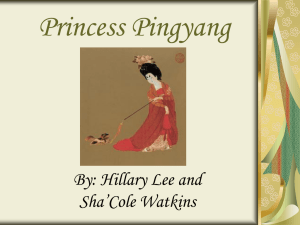The Tang Dynasty
advertisement
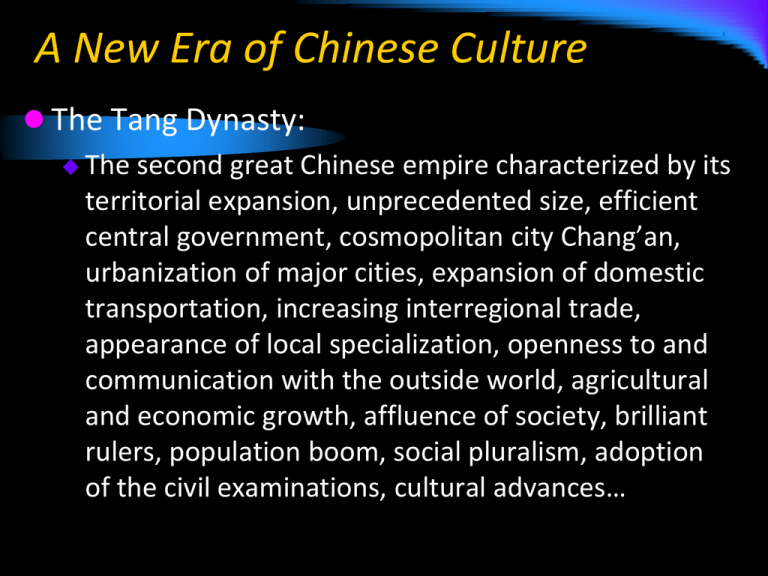
A New Era of Chinese Culture The Tang Dynasty: The second great Chinese empire characterized by its territorial expansion, unprecedented size, efficient central government, cosmopolitan city Chang’an, urbanization of major cities, expansion of domestic transportation, increasing interregional trade, appearance of local specialization, openness to and communication with the outside world, agricultural and economic growth, affluence of society, brilliant rulers, population boom, social pluralism, adoption of the civil examinations, cultural advances… The ruling house was of “barbarian” origin and the dynasty underwent continuing transformation despite an interception in the mid-eighth century: • Increased cultural and economic dominance in the south • Maritime trade developed and new harbors and entrepôt connected China with Southeast Asia, India, and the Persian Gulf through sea-based trade • spatial redefinition continued its effects, resulting in further development of social mobility and allowing southerners to take advantage of the civil service examinations to obtain official posts. The Unified China: Tang Dynasty Tang (618-906): A unified empire after the short-lived Sui (581-618) dynasty, whose founder, Li Yuan, began to restore the divided China after the collapse of the Sui. Li Yuan, founder of the Tang Dynasty China’s Dominance in Asia China’s extraordinary leadership from 581755 made the advance of China a dominant power in Asia Wendi, Yangdi of the Sui Gaozu (r. 618-627), Taizong (r.627-649), Gaozong (r.649-683), Emperor Wu (690-705), and Xuanzong (712-755) Legacy of their rules: Check-and-balance political system Effective decision-making process and control of violence • The best ordered state in the world Cosmopolitan receptivity, social pluralism Strong economy and wealthy state supported by the Grand Canal The civil service examinations Li Yuan was the founder, and his son Li Shimin brought the empire into peace and stability. Li Shimin, or Emperor Taizong (r.627-649) Vanquished the Eastern Turks, who, after being defeated, accepted Tang leadership and recognized Taizong as their Khagan (Qaghan, Khan) Established a sophisticated bureaucratic system that linked imperial court and all regions under the empire Instituted the “Equal Field” system to consolidate tax revenues and the fubing (regimental army) system Used officials steeped in Confucian learning; set up school and examination systems Taizong’s rule is characterized by: Openness to civilian talents and foreigners Legitimization of the Li family Pragmatic diplomacy (to Tibet, Korean States, and Japan) Conquered Eastern Turks and controlled Western Turks Claimed unchallenged mastery in Central Asia Elevation of Daoism Patronage of Buddhism Creation of a particular court style Cosmopolitanization of Tang capital Chang’an Creation of an innovated Chinese World Order of the Sinosphere Gaozong and Empress Wu Imperial expansion: central Asia, north Korea • Conquered Koguryo in 688 • Dealt with Khitan and Tibetan Made examinations a prestigious “fast-track” to the higher offices Promoted the Civil Service Examinations system, particularly the Jinshi degree Reasserted and extended the Daoist affiliation with the dynasty A Daoist magus Ye Fashan was called to court Wrote a preface to fascicles of Daoist canon Laozi (Lao-tzu) was awarded a deity’s name Taishang xuanyuan huangdi, or Supreme Emperor of the Mysterious Gaozong’s daughter, Princess Taiping, was given Daoist ordination The Daode jing (Tao-te ching) was made a compulsory subject in the civil service examinations Emperor Xuanzong Most glorious epoch of the Tang (712-755) – Most prosperous age Most affluent families and society Reformed equal-field system, increased agricultural productivity Prices of goods were stable – Benevolent rule Reduced the number of capital punishment Multiplied tax exemptions Expanded school system Improved health care system Xuanzong as a Talented Monarch A musician, poet, calligrapher… Known for establishing the Pear Garden Troupe—the beginning of local opera Kept a troupe of dancing horses Honored the three teachings, patronized Tantric Buddhism Established a new academy for poets Rebellion and Restoration Causes: Xuanzong’s obsession with Yang Guifei and trust in An Lushan; political struggle between An Lushan and prime minister The An Lushan Rebellion Rebels sacked and ruined the capital Emperor fled to Sichuan • Yang Guifei was strangled, and the minister slain north China laid waste Xianzong restored and rebuilt the empire (805- 860) Restoration and Rebellion Failing attempt to recover economy Suppression of Buddhism and other foreign faiths • Manichaeanism, Zoroastrianism, and Nestorian Christianity (Judaism, Islam) Large-scale rebellions in the south Foreign threat: Nanzhao, Tibet Huang Chao Rebellion Chang’an ruined again The Fall of the Tang Turks helped imperial forces to recover Chang’an first but ruined it later Warrior Zhu Wen seized control of the capital, reduced it to a wasteland Zhu Wen moved the capital to Luoyang, forced the last emperor to abdicate, assumed the throne, and founded his own dynasty— beginning of the Five Dynasties Manjusri of Mt. Wutai, Tang Dynasty
